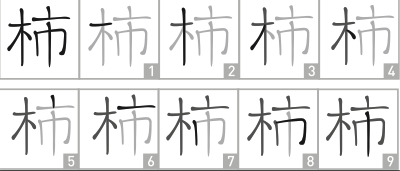Telling Persimmons from Wood Shavings
What a treat! Two years after his initial guest blog on this site, the venerable Jim Breen has returned with another great contribution. Enjoy!
❖❖❖
Telling Persimmons from Wood Shavings
Can you tell 柿 and 杮 apart? Most Japanese people can't. In fact for a long time the people in the Japanese Standards Association, which looks after computer character standards, thought just one of these kanji would suffice.
The first kanji, 柿, is read as かき and means “persimmon.” Made up of 木, 亠, and 巾, it has nine strokes. This character is not terribly common and was not included in the list of Joyo kanji until 2010. Meanwhile, the non-Joyo 杮 is read as こけら and means "wood shaving" or "shingle." This very uncommon kanji combines 木, 十, and 冂, adding up to eight strokes.

How to draw the nine-stroke 柿 (1946: persimmon).
For a magnified view of the two kanji side by side, check this link.
For many years most Japanese people treated these two characters as identical. The dictionary compilers went along with this. If you look in Nelson or in Spahn and Hadamitzky, you'll just find the one kanji used for both かき and こけら. Even Kojien (広辞苑) long used 柿 for こけら. Only extremely comprehensive Japanese kanji dictionaries, such as the 13-volume Morohashi 大漢和辞典 (だいかんわじてん), listed them as separate characters.
When the first computer codes for Japanese characters were compiled in the 1970s, it was thought that one kanji could represent both かき and こけら. The 1997 revision of the main kana and kanji standard (known as JIS X 0208) has a note explaining this decision. In 1990, an expanded "supplementary kanji" (補助漢字, ほじょかんじ) standard (called JIS X 0212) was compiled and included the real こけら (namely, 杮). That didn't change things much because Microsoft, Apple, and so forth never supported that standard, and practically no software used it. However, shortly afterward the first Unicode version was compiled. Unicode, which aims to have a single computer coding standard for all writing systems, merged the national character standards from China, Japan, and Korea in a process known as the Han Unification. The initial fusion resulted in the coding of about 20,000 characters, including both 柿 and 杮.
Over the past 20 years, more and more software has used Unicode, which means that previously ignored kanji such as 杮 have had a chance to be resuscitated. The dictionaries, at least in their electronic versions, have begun to change over to using 杮 for こけら, and finally in its sixth edition Kojien changed, too. Japanese web pages reflect that a growing number of people are using 杮 in words such as 杮落とし (こけらおとし: opening of a new theater) and 杮板 (こけらいた: thin shingles). But 柿 is still far more common; after all it's the one on the Joyo kanji list.
I don't think I've ever written either kanji by hand, but if I had to, I'm sure I'd do the eight-stroke version rather than the nine-stroke one. And I bet most Japanese people would do the same. In a way it's a pity that 杮 has come back to life; for years we got along quite happily with just the one kanji, and now there are two that look identical to almost everyone.

Photo Credit: KENPEI
It's easy to tell the persimmon fruit from the trunk, so why is it so hard to distinguish the persimmon kanji from the wood shavings character?!
❖❖❖
Editor's postscript: My proofreader disagreed with the comment "And I bet most Japanese people would do the same." The proofreader explained, "Well, actually we wouldn't because we recognize 柿 as 木 + 市, where the 市 has five strokes. We're not familiar with any kanji that looks like 市 but has only four strokes." When asked about this, Jim confessed to the deep, dark secret that he actually writes 市 as 十 and 冂 instead of 亠 and 巾, which would be correct.

Comments